Let's get this part out of the way up front: It was never actually called a Luger officially. Like many other guns of its era (such as, just to hit a couple of examples that have featured in Gun of the Week before, the Ortgies and the Frommer Stop), Georg Luger's pistol design, patented in 1898, was sold under a brand name chosen by its manufacturer, and only became known as "the Luger pistol" after the fact. Originally, the version that eventually became best-known appeared on the market as the Pistole Parabellum 08, or P08 for short. The "08" denotes the year (1908) that the pistol was adopted by the German Army; previous versions of the same design had been adopted by the German Navy in 1904 (and so are designated Pistole 04 and the Swiss Army in 1900 (you guessed it, Pistole 00).(As we have previously discussed on these boards, "Parabellum" (from the Latin phrase para bellum, "for war") was DWM's trademark for its line of weapons intended principally for military use. In that context, the Pistole Parabellum was part of a family of corporately, but not necessarily mechanically, related products, including the MG14 Parabellum aircraft machine gun.)
Luger's design was an improvement of an earlier design by Hugo Borchardt, who had developed the Borchardt C-93] while working for the German machine tool manufacturer Ludwig Loewe and Company. In 1896, three years after the C-93 went into production, Loewe and Company reorganized all its various armaments enterprises under a new subsidiary, Deutsche Waffen- und Munitionsfabriken (German Arms and Munitions Manufacturing), thenceforth known as DWM. Luger, by most accounts a protégé of Borchardt's at Loewe/DWM, later claimed that he'd had a hand in the C-93's design, and in any event he based his own popularly-eponymous pistol fairly plainly upon it.
The shortcomings in the Borchardt design Luger was trying to address are fairly evident if you look at a photograph of a C-93: the Borchardt is ludicrously unwieldy. It has that enormous spring assembly hanging off the back and its grip is pretty much straight up and down, as if it had been designed for the hands of LEGO minifigures. It was the first commercially viable semiautomatic handgun, predating the Mauser C-96 (itself not exactly an ergonomic marvel, but it must've seemed like it compared to its competition at the time) by three years, and it deserves respect for its engineering, its innovation, and the risk LL&C were willing to take on it, but as an actual shooting experience it must've been pretty hopeless.
I can't speak to that directly, however, because... well, see for yourself. Anybody out there who's rich and just all-fired eager to get my impressions of the Borchardt as a shooter, feel free to drop 18 and a half large on one for me—my birthday's in June, so you have time to save up!—but I believe I won't be buying one myself. :)
Anyway. Here's an interesting thing about the Borchardt. And the Luger, too, but it's more obvious in the Borchardt, because of that big ol' spring housing: the action is based on the one in the Maxim gun, which was the first fully automatic machine gun (as opposed to things like the Gatling and Nordenfelt rapid-fire guns, which were operated by external mechanisms). More on this in a bit; let's finish the main history lesson first.
The P08 is well-known today for its service as a sidearm for the German armed forces in both world wars; it had been replaced as the official front-line sidearm by the Walther P38 (guess the year!) by the start of World War II, but there were still a lot of them in inventory and many more privately owned by officers and others. It's also made a lot of appearances in pop culture. Its profile is so distinctive that authors, comic book illustrators, and the people who painted the covers for pulp novels routinely put Lugers, or pistols that looked reminiscent of Lugers, in the hands of anybody they wanted to make a particular impression. Generally a sinister impression. Quite often a Nazi impression.
Anyway, I'll have to admit at this point that what I have, and will be showing you in a moment, is not, properly speaking, an authentic German P08. Virtually every manufacturer in Germany made them at one point or another between the World Wars, not just DWM, but mine was made by none of them. It was, in fact, made in the United States, and much more recently. It's had a cameo appearance already, in the article about the Ruger .22, but here it is in its own starring role.
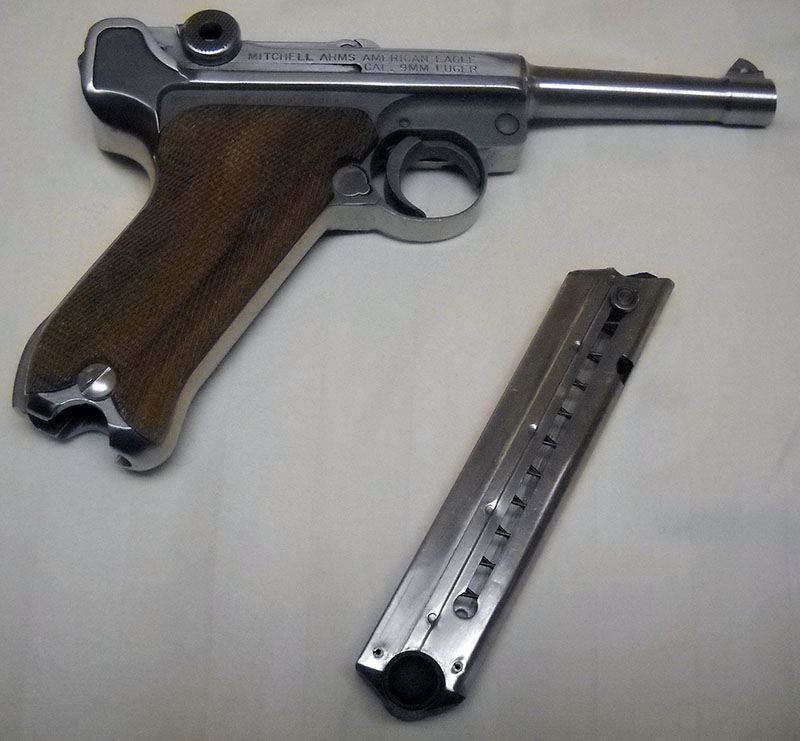
This is, as the engraving on the side suggests, a Mitchell Arms American Eagle. The name is kind of a riff on an older one. We've seen before that placing the national crests of purchasing countries on the tops of pistols used to be a common practice; well, back before World War I—in fact, before the pistol was adopted by the German Army—DWM had hopes of interesting the United States military in Herr Luger's stylish new pistol. The US Army was then testing various handguns in search of a self-loading replacement for its aging stock of revolver sidearms, and DWM's management wished to take part. As part of the marketing push surrounding this move, the company produced a run of Model 1906 Lugers specifically for export to the USA; these were marked, after the tradition of the time, with an American eagle crest on the top of the barrel, and so naturally became known as "American Eagle" Lugers.
In the event, the prototypes submitted by DWM did fairly well in the first round of Army tests—well enough that they were invited back for the second round, along with Colt, who had entered with a design by John Browning. Participating in the second round of tests would have required DWM to produce 200 further pistols in the American-specified .45 ACP cartridge, however, and as the company had no other customers who were even slightly interested in a handgun employing that cartridge and the German Army had just adopted the regular 9mm version, they opted not to take part. (Colt eventually won the competition with what became the Model 1911, of course.)
It's interesting to pause here for a moment and consider what would have happened if DWM had chosen to participate in, and then won, the second round of the trials. The United States Army would have standardized on a German-made pistol three years before the outbreak of World War I interrupted trans-Atlantic trade and placed enormous, eventually fatal strains on US-German relations; by mid-1917 the US was in the war, and not on the side friendly to Germany. It would have been... awkward. But interesting!
At any rate, it didn't happen. Eighty-odd years later, when an American company decided to start producing P08 clones, someone had the clever idea of hearkening back to the classic, collectible "American Eagle" versions from 1906 by adding an eagle crest to their own new product and naming it accordingly.
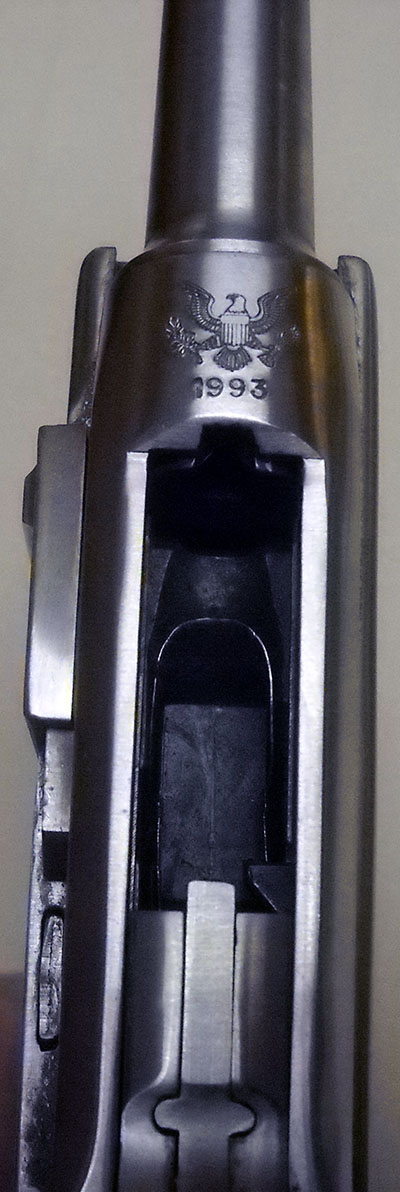
They were also considerate enough to date them!
Also notable in the top view above is the open chamber; like the Type 14 Nambu and a few other auto pistols of the era, the P08 ejects through the top. Because of the unusual action, it doesn't have a slide as such, so no need for a side-ejection port. There's also a good view of the extractor (on top of the bolt) and the magazine well and follower here.
Over on the other side, we can see that the P08 is not symmetrical.
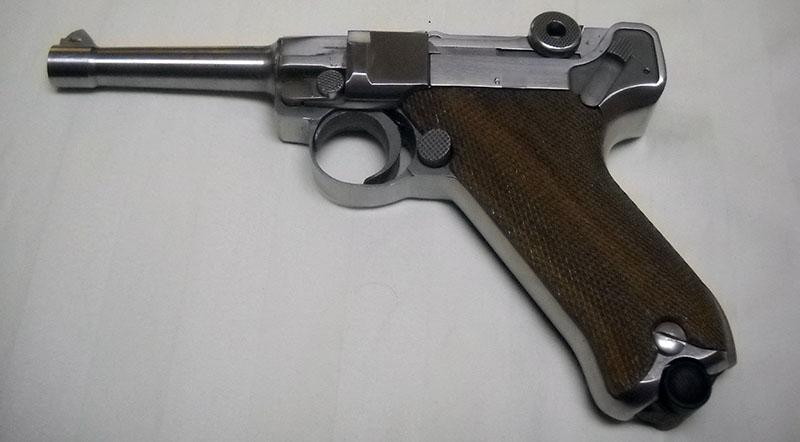
That lever just below where the barrel meets the frame is the disassembly lever, which, when flipped down, allows the side plate behind it to be removed. This, in turn, enables the barrel and bolt assembly to be taken off by sliding it forward. I don't have the tool that enables people with mere mortal fingernails to operate the takedown lever comfortably, so I didn't take mine apart, but if you're interested in the process, you can find a nice photo set about it here.
A note about that side plate: it serves an important safety function, in that it covers part of the trigger mechanism that would otherwise be external. Remember the Type 94 Nambu's habit of going off if holstered incautiously? That happens because it has a similar trigger mechanism and it does't have a plate like that. You can similarly drop the striker on this pistol without touching the trigger by poking a particular bit of the device that's hidden behind that plate. So, nicely done, Mr. Luger, thanks for thinking of us.
The Luger (I'm going to keep calling it that, as a shorthand for the whole family of pistols based on Luger's action) is a short-recoil, toggle-locked, striker-fired semiautomatic design. Under firing, the barrel comes back a few millimeters before it stops and the action unlocks, at which point the toggle bends upward, drawing the bolt back. You can see both of these things in action in this photo of the pistol with its action locked open (which, like many semiautos, it does automatically when the last round is fired, or when opened on an empty magazine):
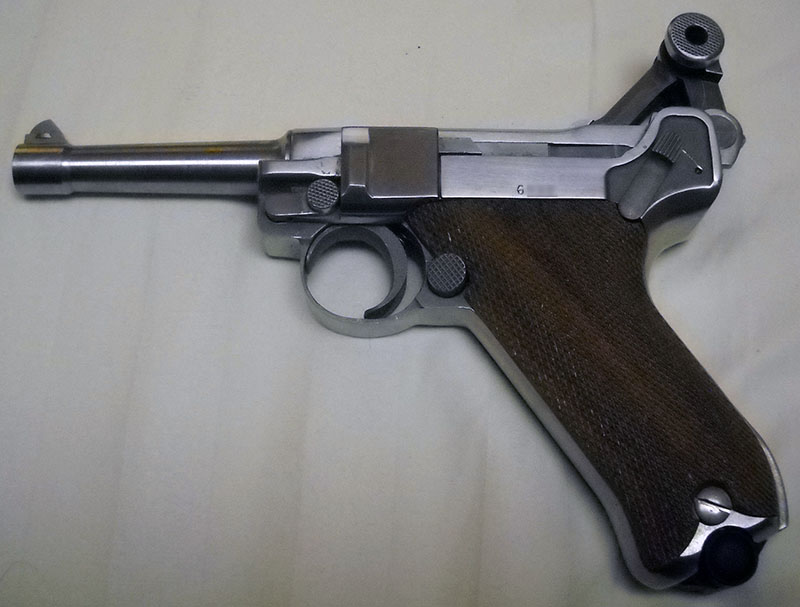
Note that the barrel is fully back here (readily evident when compared with the photo of the closed pistol, particularly in the position of the "shoulder" of the barrel relative to the frame). One interesting feature of the toggle design is that, unlike a conventional slide-operated semiauto, it's horizontally contained; nothing comes back out over the shooter's hand. Behind the reciprocating bolt, the action is translated vertically by the action of the toggle. There are those who will tell you that this makes the Luger more accurate than mere mortal pistols, because there's less mass moving around horizontally, but I'm not sure I buy that argument. At the very least it's highly subjective.
One other feature on the left side that's worth a look is the safety. Here it is in the "fire" position:
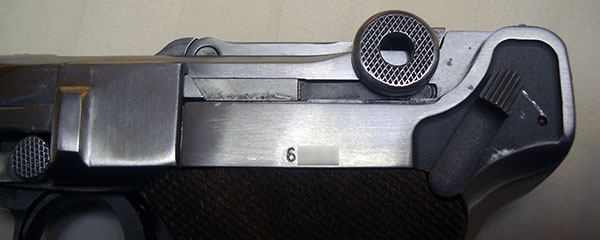
That exposed bar you can see below the knurled toggle is part of the trigger mechanism. The light-colored bit toward the front moves outward when the trigger is pulled, allowing the dark-colored bit behind to move forward, releasing the striker and firing the pistol. Engaging the safety...
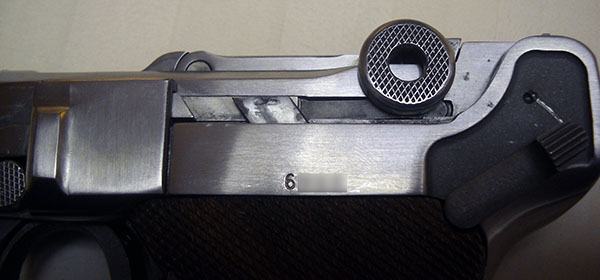
... physically moves a metal tab into position over the outward-flexing part, blocking it from moving and thus preventing it from freeing the striker. It's interesting that this all happens on the outside of the weapon; on the one hand, it makes it easy to tell by sight (or even feel) whether the safety is really engaged, but on the other, it makes the whole works that much more vulnerable to dirt and contamination.
That's really the downfall of the Luger from a military-sidearm standpoint. It's so complicated, and requires such precise construction, that it's very time-consuming and expensive to produce relative to simpler designs like its successor, the P38; and that same fineness of engineering means that it's not very tolerant of less-than-ideal conditions, which, let's face it, military hardware encounters a lot.
Here's another look at the complexity we're talking about. This is a view of the action from the front, showing the bolt face, with good views of the extractor and the hole for the firing pin, plus another angle on the various joints and surfaces involved in the toggle action.
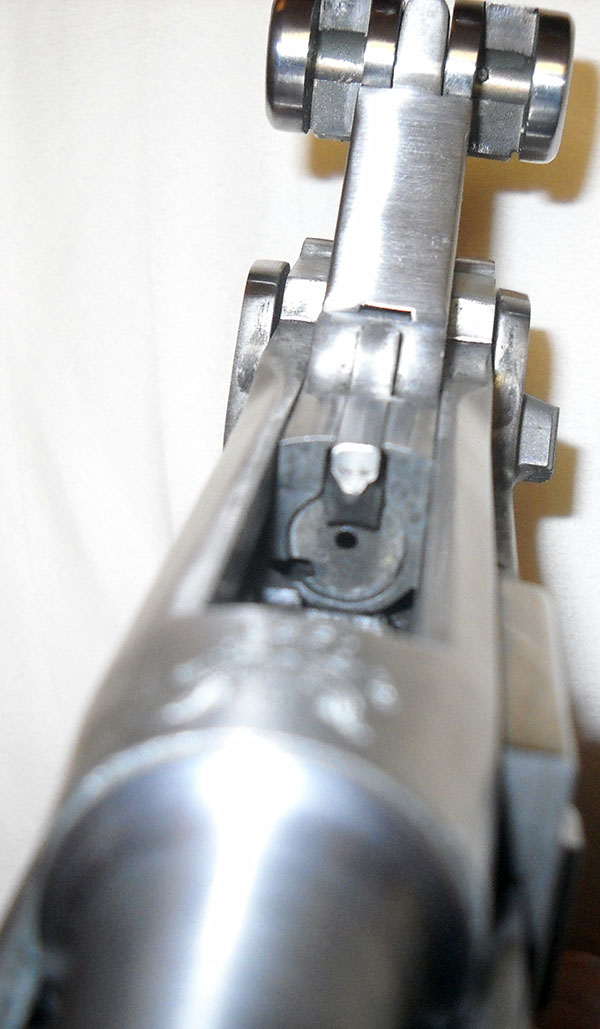
It's a beautiful design from an engineering perspective, don't get me wrong, but unfortunately it has a nasty habit of not working very well under any but the most ideal conditions. If not meticulously maintained and jealously guarded against hostile environments, it won't work reliably, and unreliability is the least forgivable fault of army weapons.
I admit my experiences with this particular one may have colored my perceptions a bit. As you can see, the Mitchell American Eagle is made of stainless steel, which is not the material Georg Luger was designing for. Stainless is a popular material for handguns nowadays, because it's sturdy, highly corrosion-resistant (pretty much rustproof under ordinary, everyday conditions), and pretty; but it has interesting mechanical properties that make it a bit of a challenge to make firearms out of. Friction-bearing surfaces work differently when made from stainless than they do when made out of milder steels. What this means in practice is that you can't just take a successful design originally created for regular steel, start making it out of stainless instead, and expect it to work. Some re-engineering is required to adjust the tolerances and make the mechanism work reliably in the new material.
The Mitchell attempt to do this with the Luger action was... not entirely successful, in my experience. Maybe that's just the particular one I have, but whatever the reason, I bought this one new in 1996 (so it had sat unsold on the shelf for three years, which should tell you something right there) and I've never been able to get it to work properly. It's extremely finicky about the type of ammunition that's put into it (which is, in fairness, a trait it shares with "real" Lugers and indeed a good many other semiautomatic firearms), and even with its "favorite" types as determined so far, it only works about 60 percent of the time. The rest of the time it finds various new and creative ways of failing to function, usually by not ejecting and/or feeding properly. Stovepipe jams (ejection failures in which the case ends up wedged vertically in the action, creating the obvious visual) and double feeds (gun tries to load a new round into a chamber still occupied by the empty case of the previous one) are its specialties.
This was apparently a recognized problem when the gun was new; I wrote to Mitchell Arms complaining about it shortly after I bought the piece, and they offered to take it back into the factory for an overhaul, free of charge. This led to an amusing scene at the Mail Boxes Etc. near where I worked in Pleasanton, California, when the time came for me to ship the gun back to the factory in Texas. I had the necessary credentials to own firearms and transport them to and from the firing range under very specific conditions, but not to carry them on my person (concealed or otherwise), so I had to take the pistol from my house to MBE in its locked case, as per regulations. Trouble was, Mitchell had specified that I should UPS it back to them in the box it came in, not in any kind of third-party case and certainly not locked.
What this meant was that once I got to MBE, I had to unlock the case, take the gun out of it, put it back in its original factory box with the cardboard standoffs and bits of foam and whatnot, tape it up, and ship it that way. And of course, when I walked into the MBE, the place was moderately busy and one of the people transacting some shipping-related business there was an Alameda County sheriff's deputy.
How do you open in a situation like that? Twenty-three-year-old country bumpkin me went for the General Announcement strategy. "Hi. Everyone? I don't want to alarm anybody, but I have to send a firearm in for service, and that means I'm going to have to take it out of this case here and pack it up for shipment. I don't have any ammunition for it or anything. There's nothing to worry about. It doesn't work anyway, that's why I'm sending it back."
Now I will be the first to acknowledge, here today, that that was a dumb way to do that. It relies on a group of bystanders and a law enforcement officer parsing the text of a message delivered in what, I realized after the fact, is the same manner that "nobody moves, nobody gets hurt" is usually conveyed with. But here's the thing: nobody cared. The civvies all kind of shrugged and went about their business; the deputy came over to watch me repack the gun, but he seemed more curious about what kind it was and what was the matter with it than wary of trouble. It was all very amiable. I suspect if you walked into a UPS Store today and tried to carry out a similar bit of business, you'd end up explaining it to the hood of the deputy's cruiser, if not worse. But it was 1997, and I was young and foolish enough to think that was the right way to do it, and I got away with it.
And then it came back from the factory a couple of months later and still didn't work right, but what can you do. I'm oddly attached to it anyway just because we lived that little slice of stupid together. And maybe it just needs more oil and a still-better grade of ammunition, I don't know. I should keep experimenting in my copious free time.
Speaking of things that are kind of annoying about the Luger, take a look at the magazine.

This is a single-stack magazine holding, if memory serves, eight rounds, with one of the stiffest follower springs ever fitted. That little button on the follower? Will bust your thumb if you try to work it manually, especially as you get farther down and the spring resistance gets higher and higher. Real German Lugers came with a little tool for operating both that button and the takedown lever, either of which will defy mortal fingers. I had some improvised success with a big hex nut back when, but modern ingenuity has also come up with gadgets like this one:

This gadget won't help you with the takedown lever, but it does do a nice job of operating the magazine spring without ripping all the flesh off your thumb. It'll even compress the spring all the way to the bottom and lock there:
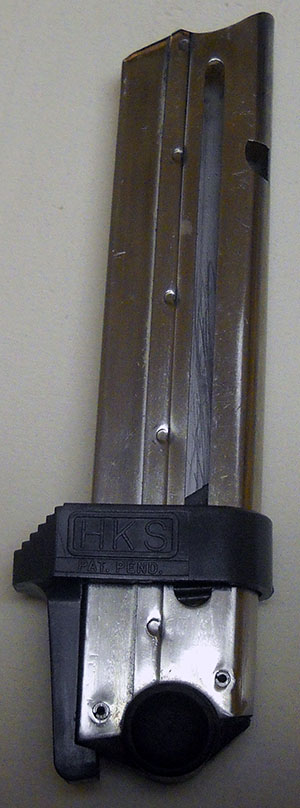
though I find that loading tends to work better if you don't lower the follower to the point where the next round you put in can end up vertical. Takes a bit of fiddling to lay it down again if that happens.
Ruger .22 magazines work this same way, as do Nambu Type 14 magazines. The .22 magazines are even more annoying, because the button is smaller and sharper, but the spring is a bit weaker, which makes up for it a little.
Anyway, that's my little piece on Georg Luger's famous pistol. There are much, much more comprehensive studies of this firearm, unsurprisingly. You can spend basically as much money as you want on the literature surrounding Lugers, just as you can spend basically as much money as you want collecting the pistols themselves. Simpson Ltd., the collector gun shop whose Borchardt listing I linked above, started as a Luger fancier's personal collection and branched out from there, and publishes a colossal reference work on the subject, The Borchardt and Luger Pistols. This is basically the OED of Luger references, and costs about the same, too.
I always meant to get myself a "real" Luger one of these days, but never got around to it. This is a bit sad, as it means I've left it too long and will now no longer be able to get it from the delightfully named website "Ralph E. Shattuck's World of Lugers", as I always vaguely intended to, as the eponymous Mr. Shattuck has sadly died. These days they're largely out of the reach of mortal punters like myself anyway, though I'd be helped a little bit in my search, if I restarted it, by the fact that I'm not very particular about the minutiae. If anything, I'd rather not have one with Third Reich Waffenamt markings. I'm a bit of a rarity in 20th-century-European-firearms collectors in that I don't want any dang swastikas on my guns. I know, right? Go figure.
As a parting note, I should mention that mechanically, the P08 itself didn't have much influence in weapons designs that followed, apart from possibly encouraging designers to seek other ways of doing it, but it was influential in at least one significant way: the super-popular 9x19mm Parabellum cartridge was originally developed for it, which is why it is also sometimes known as "9mm Luger".
--G.
-><-
Benjamin D. Hutchins, Co-Founder, Editor-in-Chief, & Forum Mod
Eyrie Productions, Unlimited http://www.eyrie-productions.com/
zgryphon at that email service Google has
Ceterum censeo Carthaginem esse delendam.


 RE: Gun of the Week: Luger
RE: Gun of the Week: Luger RE: Gun of the Week: Luger
RE: Gun of the Week: Luger
 RE: Gun of the Week: Luger
RE: Gun of the Week: Luger RE: Gun of the Week: Luger
RE: Gun of the Week: Luger
 RE: Gun of the Week: Luger
RE: Gun of the Week: Luger RE: Gun of the Week: Luger
RE: Gun of the Week: Luger RE: Gun of the Week: Luger
RE: Gun of the Week: Luger
 RE: Gun of the Week: Luger
RE: Gun of the Week: Luger RE: Gun of the Week: Luger
RE: Gun of the Week: Luger RE: Gun of the Week: Luger
RE: Gun of the Week: Luger
 RE: Gun of the Week: Luger
RE: Gun of the Week: Luger RE: Gun of the Week: Luger
RE: Gun of the Week: Luger
 RE: Gun of the Week: Luger
RE: Gun of the Week: Luger RE: Gun of the Week: Luger
RE: Gun of the Week: Luger RE: Gun of the Week: Luger
RE: Gun of the Week: Luger
 Printer-friendly copy
Printer-friendly copy














